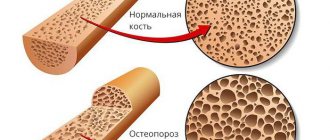Indications
There are a number of diseases and conditions when a macronutrient deficiency occurs. The medication is taken for treatment and prevention:
- Postmenopausal and senile osteoporosis
- Nervous system diseases
- Allergic reactions
- Metabolic disorders after 60 years
- Periodontitis
- Bone disorders (living in unfavorable regions)
- Systemic osteoporosis.
The solution is prescribed as an addition to the main therapy.
Calcium Sandoz Forte is indicated in the following cases:
- Pregnancy
- Lactation
- The period of formation of the child’s skeleton
- Preventing heart disease
- Decreased ability to work
- Muscle pain, cramps (increased excitability of the neuromuscular system)
- Unhealthy complexion, dull hair.
Calcium Sandoz Forte is prescribed not only to support bone tissue. The solution is recommended for use for the prevention of cancer, arrhythmia, and atherosclerosis.
Side effects
In general, the drug is well tolerated. In rare cases, the following are noted:
- Hypersensitivity reactions, incl. hypercalcemia, itching, rash, urticaria;
- Systemic allergic reactions - facial swelling, angioedema, anaphylactic reactions;
- Nausea, vomiting, flatulence, epigastric pain, constipation or diarrhea.
With long-term use of Calcium Sandoz Forte in high doses (2000 mg per day), headache, polyuria, and increased fatigue are possible.
An overdose of calcium leads to the development of hypercalciuria and hypercalcemia, manifested by thirst, nausea, vomiting, polyuria, polydipsia, dehydration and constipation. Chronic overdose with hypercalcemia can lead to liming of organs and blood vessels. The threshold for intoxication is long-term intake (for several months) of more than 2000 mg of calcium per day.
At the initial stage of chronic overdose, the body is hydrated using a 0.9% sodium chloride solution. In some cases, loop diuretics are used - they help enhance the excretion of calcium and prevent the formation of edema in the tissues. In case of intoxication, it is necessary to restore the water and electrolyte balance.
In case of persistent hypercalcemia, additional examination is prescribed to exclude other factors contributing to its development, including hypervitaminosis D and A, renal failure, primary hyperparathyroidism, stiffness of movement, and malignant tumors.
In patients with kidney failure, hydration is ineffective, so they are given dialysis.
Medicinal properties
The medicine contains 2 salts – Calcium lactate gluconate and Calcium carbonate. The effervescent tablet dissolves in water. Organic salts completely (100%) go into solution. The macronutrient is much better absorbed by the body.
When preparing a solution, Calcium carbonate interacts with citric acid and a chemical compound is formed - Ca₃(C₆H₅O₇)₂. Calcium Sandoz Forte is safe. The second generation drug reduces the risk of stone formation and dissolves them in the kidneys. It is absorbed regardless of food intake and the acidity of gastric juice. The product reduces the risk of constipation.
Clinical studies have been conducted that have shown that the role of the element in the body is great. In postmenopausal women, bone tissue changes. This happens due to a decrease in estrogen levels. Sufficient intake of macronutrients into the body and physical activity are important conditions in the postmenopausal period.
To prevent a negative balance, you should drink Calcium Sandoz Forte at least 1000 mg per day. It is recommended to take the medication in the evening. This is the most effective.
The medication eliminates seizures and normalizes blood pressure. It is used in aesthetic medicine. Taking the medicine reduces the risk of bone fractures and inhibits tissue resorption. To prevent systemic osteoporosis, the macronutrient must be taken for a long time. The dose of the drug should be sufficient.
Calcium Sandoz Forte has good bioavailability, so it is often chosen for treatment and prevention. The medication replenishes the mineral element and participates in metabolism. It has antiallergic, vitamin, anti-inflammatory, antirachitic effects. The solution will also compensate for the lack of drinking water.
When taking the medicine for a long time, it is necessary to regularly monitor the level of the element in the urine and blood.
Pharmacological profile
Calcium Sandoz belongs to a group of drugs that normalize calcium deficiency in the body.
Calcium is the main component that is necessary for the human body. It is responsible for the regulation of various important processes in the body, maintains the balance of electrolytes and takes part in calcium phosphate metabolism.
The drug Calcium Sandoz replenishes the lack of calcium during metabolic disorders in bone tissue. In addition, the product has antirachitic and antiallergic effects.
This medicine contains two calcium salts, which instantly dissolve in the composition of effervescent tablets, as a result of which they become active. Thanks to the transition to this form, the medicine is quickly absorbed and promotes the rapid entry of calcium into the body.
Approximately 25-50% of calcium in an ionized state is absorbed into the walls of the small intestine. The highest level of this component is observed in bone tissue and teeth - almost 99%, 1% is included in the extracellular fluid.
Almost 50% of calcium in the ionized active state is observed in the blood - about 5% in the form of anionic complexes, 45% is associated with proteins. Approximately 20% of the drug is excreted through the kidneys in the urine. Almost 80% of the medication is excreted in the feces.
Mode of application
The medicine is dissolved in 1 glass of water (200 ml). Prescribe 1–2 pcs. per day 1000 or 500 mg. The dosage is calculated depending on age and purpose. The amount of mg is:
- 1000 – adults and children over 10 years old
- 500 – for children from 3 to 9 years old.
In some cases, up to 2000 mg is recommended. The instructions contain a treatment plan. Duration of treatment is at least 4–6 weeks. It is recommended to take the medication in the evening. This is the most effective. This is due to circadian changes in bone resorption. They are most pronounced in the morning.
To prevent osteoporosis, patients are periodically prescribed Calcium Sandoz Forte, but intermittently. The disease is treated until bone tissue is restored.
Signs of calcium deficiency
The macroelement, along with other useful substances, is necessary for a person to ensure normal functioning, especially for the strength of bone structures and teeth. The body of a healthy person (adult) contains approximately 1000 g of calcium. The result of a sufficient dose of the chemical is the absence of problems with blood clotting, normal functioning of the muscles and thyroid gland, and the free passage of nerve impulses.
A lack of a mineral that can be washed out of skeletal structures is indicated by the following symptoms:
- Weakness and increased fatigue;
- Drying of the skin, peeling of the skin;
- Brittle nails, destruction of tooth enamel (caries);
- The appearance of bone pain, cramps, numbness of the fingers;
- The development of osteoporosis due to increased bone fragility;
- Signs of heart failure, heart problems;
- Increased nervous excitability, thyroid diseases.
Doctors consider Ca+ ion deficiency in young children to be especially dangerous.
The situation threatens to delay the growth and development of the child, disrupt the formation of bone tissue and teeth, and the lens of the eye undergoes pathological changes. The most dangerous sign of hypocalcemia in childhood is the phenomenon of poor blood clotting.
Contraindications
Calcium Sandoz Forte is not prescribed if the patient has:
- Burnett's syndrome (increased Ca concentration in the blood)
- Increased urinary Ca excretion
- Disease of the endocrine system (hyperparathyroidism)
- Kidney failure, CKD
- Diffuse salt deposition in the kidneys
- Inborn error of metabolism (Phenylketonuria)
- Children under 3 years old
- Enzyme deficiency of sucrase-isomaltase
- Allergic reactions
- Intolerance to components.
Release form and composition
Calcium Sandoz Forte is available in the form of effervescent tablets, 10 and 20 pcs. in polypropylene cases, one case in a cardboard box.
Active ingredients of the drug:
- Calcium lactogluconate – 1132 mg or 2263 mg per tablet;
- Calcium carbonate – 875 mg or 1750 mg per tablet.
* which corresponds to the content of 500 mg or 1000 mg Ca 2+ in one tablet, respectively.
Auxiliary components: citric acid, macrogol 6000, aspartame, sodium bicarbonate and orange flavor containing sorbitol, butylated hydroxyanisole (E320) and sulfur dioxide (E220).
Cross-drug interactions
If the interaction of the drug with other substances is not taken into account, the therapy does not give the desired effect or is harmful. Ca salts reduce the absorption of the following drugs from the gastrointestinal tract:
- Tetracyclines
- Fluoroquinolones
- Sodium fluoride
- Levothyroxine
- Estramustina
- Bisphosphonates
- Ferrous sulfate
- Strontium ranelate.
It is recommended to maintain an interval of 2–4 hours between taking Ca and medications. Features of the interaction of Calcium Sandoz Forte with other substances:
- With vitamin D – they potentiate each other’s actions. Calcium inhibits the effect of Verapamil
- When taken concomitantly with thiazide diuretics, monitor blood Ca levels.
- The toxicity of cardiac glycosides increases.
You cannot take Ca and products containing phytic and oxalic acid at the same time. An interval of 2 hours should be maintained.
special instructions
When taking Calcium Sandoz Forte during pregnancy, in order to prevent the development of hypercalcemia, which can cause disturbances in the fetus, the dose should not exceed 1500 mg per day.
Patients with mild to moderate renal dysfunction, with slight hypercalciuria (exceeding 7.5 mmol/day), as well as a history of urolithiasis, require regular monitoring of urinary calcium excretion. If necessary, reduce the dose or discontinue the drug. In case of impaired renal function, the level of calcium and phosphate in the blood serum should also be monitored.
Patients with a tendency to form stones in the urinary tract should drink plenty of fluids during treatment.
Unless there are special indications for this, you should not take vitamin D and its derivatives in high doses while taking Calcium Sandoz Forte.
People following a diet with limited salt intake should take into account that 1 500 mg tablet contains 2.976 mmol of sodium, 1 1000 mg tablet contains 5.95 mmol (equivalent to 68.45 and 136.90 mg of sodium, respectively).
1 tablet of Calcium Sandoz Forte contains 0.002 XE, so the drug can be taken by patients with diabetes.
The mineral supplement does not have a negative effect on the ability to concentrate and visual acuity.
The absorption of calcium from the gastrointestinal tract is reduced by foods containing oxalic acid (for example, rhubarb and spinach) and phytic acid (cereals). For this reason, you should not take calcium 2 hours before or 2 hours after eating such a meal.
Analogs
Complivit Ca D3
Pharmstandard, Russia
Price: 390–455.71 rub. №100
Chewable tablets with orange flavor. The surface is rough. The shape is biconvex. Color – white interspersed with grey.
Tablets in a polypropylene jar, 100 pcs. Instructions: Contains CaCO₃ and D₃. The drug is prescribed in complex therapy.
The instructions for use say that the product reduces resorption and increases bone density. The medicine regulates the exchange of phosphorus (P) and Ca.
Pros:
- Can be given to children from 3 years old
- The tablet is chewable and has a pleasant taste.
Minuses:
- Possible constipation, diarrhea
- It is necessary to control the intake of colecalciferol.
Alfadol-Sa
Panacea Biotic, India
The price is 453.00 rub.
Pack of 30 pcs. Green colour. Gelatin capsules, soft.
Alfadol-Sa is available with a prescription. Indications for use include: osteoporosis, osteodystrophy, renal failure.
Pros:
- Does not form kidney stones
- Good absorption.
Minuses:
- Therapeutic doses of vitamin D should not be prescribed
- During pregnancy, take only as directed by a doctor.
- Side effects are noted.
Why do you need to solve the problem?
Calcium deficiency in the body leads to the following consequences:
- Drowsiness and constant unreasonable fatigue.
- Deterioration in performance, chronic loss of strength.
- Teeth crumbling, nails peeling, hair brittle.
- Pallor of the skin.
- Joint pain of uncertain localization.
- Cramps of the calf muscles.
- Tendency to bleed.
- The appearance of bruises on the body for no reason.
- Increased sensitivity of tooth enamel to hot or cold foods, drinks, or even air.
- Recurrence of caries.
- Development of hay fever, allergies, diathesis.
- Weakening of the immune system.
- Frequent exposure to influenza, colds, as well as complications in the form of frontal sinusitis, otitis media, sinusitis, tonsillitis, etc.
- Osteoporosis, which can lead to numerous dislocations, frequent fractures and other problems with joints and bones.
- Arterial hypertension.
- Cardiovascular diseases, increased risk of stroke.
To protect yourself from all these consequences, you need to eat a balanced diet. And if you cannot get enough of a valuable macronutrient from food, then you need to resort to supplements. Doctors often prescribe Calcium-Sandoz. What kind of drug is this?
Reviews: advantages and disadvantages
Leave your reviews about the MIK Forte complex right here by filling out a special form.
| Leave feedback | |
| 1 2 3 4 5 | |
| Send Cancel | |
Send your review
MIC Calcium D3 forte
Average rating: Number of reviews: 0
Pros:
- The dietary supplement improves the condition of hair and nails.
Minuses:
- the drug has a large list of contraindications;
- small packaging volume.
Who is recommended to take the drug?
Calcium Sandoz-Forte is taken for the following conditions and diseases:
- during preventive and therapeutic therapy for calcium deficiency, namely during pregnancy, during breastfeeding, during the active period of child growth;
- during osteoporosis in postmenopausal women;
- with osteoporosis of unknown origin;
- with insufficient calcium in the diet;
- in combination with vitamin D3 during the treatment of osteomalacia;
- for various manifestations of an allergic nature;
- during the latent course of tetany - convulsions.
Pharmacokinetics
About 25-50% of the dose of the drug "Calcium-Sandoz" is absorbed in the proximal small intestine, after which it is transported to calcium exchange depots.
As many people know, 99% of macronutrient reserves are found in teeth and bones. The remaining 1% is contained in extra- and intracellular fluid.
About 50% of the macronutrient found in the blood is present in active ionized form. Approximately 5% form complexes with phosphate, citrate and other anions. And another 45% binds to proteins, mainly albumin.
Approximately 20% of calcium is excreted from the body through the kidneys. The activity of this process depends on tubular reabsorption and glomerular filtration.
The rest is excreted through the intestines. This leaves the body with both absorbed and unabsorbed calcium.









